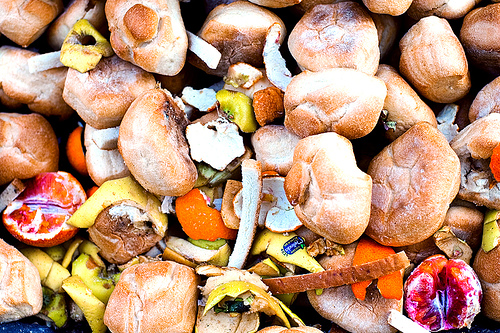雖然今日對於糧食生產對環境的影響,全球均有共識,但至今仍缺少從環境觀點分析食物浪費的研究。
聯合國11日發表「食物浪費足跡:食物浪費的環境衝擊」報告指出,每年全世界有三分之一,高達13億噸的食物被浪費掉,造成每年7500億美元的經濟損失和龐大的環境成本。
這是第一份從環境觀點分析全球食物浪費及其影響的研究,分別探討了食物浪費對氣候、水資源、土地利用和生物多樣性的衝擊。
研究者發現,每年因為生產這些被浪費掉的食物,幾乎用掉俄國伏爾加河一年的水流量,這些未被吃掉的食物佔據近14億公頃的土地,而根據這份報告,14億公頃的土地等於是全世界農地面積的28%,且這些未被吃掉的食物還為地球增加33億噸的溫室氣體。
報告指出,各地區有不同的食物浪費特徵。穀類,尤其是稻米浪費在亞洲特別嚴重,造成碳排放增加以及水資源和土地利用的浪費。水果類的浪費在亞洲、拉丁美洲和歐洲較嚴重,蔬菜浪費則在亞洲工業化地區、歐洲、南亞和東南亞產生大量的碳足跡。除了拉丁美洲外,高收入地區產生的食物浪費佔整體的67%。
報告進一步說明,食物浪費不僅是全球食物安全的一大隱憂,也增加環境負擔、不利於食物鏈資源的有效利用。「雖然食物浪費對全球生物多樣性的衝擊難以量化估計,但食物浪費間接助長單一作物和農業擴張入侵未開發地區,造成生物多樣性流失,哺乳類、鳥類、魚類和兩棲類都受到影響。」報告總結道。
聯合國糧農組織也隨報告發表了一套完整減少食物浪費的指南,說明如何在食物鏈的各個階段減少浪費。這套指南還詳細列出世界各國及地方政府、農民、企業和個人消費者的減少食物浪費方法。
聯合國環境規劃署執行長史坦納(Achim Steiner)表示,「聯合國糧農組織的報告列出許多實際的好處,家庭、商店、餐廳、學校和企業都能透過簡單、聰明的辦法為環境的永續性、經濟的改善、食物安全和達成聯合國秘書長的零飢餓計畫盡一份心力。」
One-third of all the world’s food is wasted every year at enormous economic and environmental cost, finds a United Nations report released Wednesday.
The report, “Food Wastage Footprint: Impacts on Natural Resources,” is the first study to analyze the impacts of global food wastage from an environmental perspective, looking at its consequences for the climate, water and land use, and biodiversity.
The waste of 1.3 billion tons of food each year is damaging to the environment and causes economic losses of US$750 billion a year, according to the report.
The researchers found that food produced but not eaten each year guzzles up a volume of water equivalent to the annual flow of Russia’s Volga River
The production of this uneaten food is responsible for adding 3.3 billion tonnes of greenhouse gases to the atmosphere.
This food wastage represents not only a missed opportunity to improve global food security, but also to mitigate environmental impacts and resources use from food chains, the report states.
Although there is today a wide recognition of the major environmental implications of food production, no study has yet analysed the impacts of global food wastage from an environmental perspective.
Produced but uneaten food occupies almost 1.4 billion hectares of land; according to the report this represents 28 percent of the world’s agricultural land area.
“While it is difficult to estimate impacts on biodiversity at a global level, food wastage unduly compounds the negative externalities that monocropping and agriculture expansion into wild areas create on biodiversity loss, including mammals, birds, fish and amphibians,” the report concludes.
The report points out specific features of food waste according to regions. Cereal waste, particularly waste of rice, is a big problem in Asia, with major impacts on carbon emissions as well as water and land use.
Fruit wastage contributes to water waste in Asia, Latin America, and Europe, while large volumes of vegetable wastage in industrialized Asia, Europe, and South and South East Asia translates into a large carbon footprint for that sector.
Excluding Latin America, high-income regions are responsible for about 67 percent of all meat waste.
As a companion to its report, the Food and Agriculture Organization has also published a comprehensive tool-kit with recommendations on how food loss and waste can be reduced at every stage of the food chain. The tool-kit gives examples of projects around the world that show how national and local governments, farmers, businesses, and individual consumers can take steps to tackle the problem.
Executive Director of the UN Environment Programme Achim Steiner said, “Today’s excellent report by FAO underlines the multiple benefits that can be realized – in many cases through simple and thoughtful measures by for example households, retailers, restaurants, schools and businesses – that can contribute to environmental sustainability, economic improvements, food security and the realization of the UN Secretary General’s Zero Hunger Challenge.”
※ 全文及圖片詳見:ENS





